|
|
|
Sort Order |
|
|
|
Items / Page
|
|
|
|
|
|
|
| Srl | Item |
| 1 |
ID:
140763
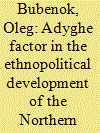

|
|
|
|
|
| Summary/Abstract |
The 150th anniversary of the end of the Caucasian War, which caused havoc in the lives of the Circassians, coincided with the 2014 Winter Olympics in Sochi organized on the land where Circassians (Adyghes) had long lived. These two events revived an interest in the Circassian question and showed that the lacunae in the history of the Adyghes, making an unbiased approach to the issue, impossible should be filled with facts. Repatriation of the Circassians to the Caucasus and a unified Adyghe republic are impossible in Russia’s political reality.
|
|
|
|
|
|
|
|
|
|
|
|
|
|
|
|
| 2 |
ID:
069841
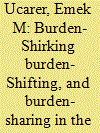

|
|
|
| 3 |
ID:
107545


|
|
|
|
|
| Publication |
2011.
|
| Summary/Abstract |
In this paper the authors explore alternative discursive constructions by Kazakhs in Mongolia and Kazakhstan of a 'Kazakh homeland', one which is markedly not coterminous with the borders of any state. As the use of nomadic pasture lands cut through and across state borders in the last centuries, so do contemporary Kazakhs describe and justify a variety of other cultural practices, from visiting shrines to obtaining illegal passports, in terms of a shared 'Kazakh' cultural history of movement. The stories people evoke and tell about the connection and 'Kazakhness' (Kazakhshylykh) evidence the simultaneous idealization of both ancestral rootedness and mobility as fundamental to a sense of 'belonging' to the land. This ancestral world also reveals the fundamentally arbitrary nature of borders in a world where belonging is made by moving: moving through space, moving through time. From such discursive temporal and spatial practices of passing and dwelling emerges a cultural-historical position that ultimately transcends the region's colonial history and its current nationalizing states.
|
|
|
|
|
|
|
|
|
|
|
|
|
|
|
|
| 4 |
ID:
184787
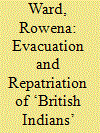

|
|
|
|
|
| Summary/Abstract |
In 1940, the Indian population resident in Japan was estimated at over 500. With the potential for war with Japan increasing, the British embassy in Tokyo advised locally resident British subjects to leave in October 1940 and again in February 1941. However, some, including a number of Indians, chose not to leave. This article considers the evacuation of the Indian population from Japan before December 1941 as well as those who departed as part of the wartime Anglo-Japanese Civilian Exchange. In doing so, it discusses the use of the SS Anhui to evacuate British subjects and also the lack of safe conduct for the City of Paris, which carried the Indian repatriates back to Bombay.
|
|
|
|
|
|
|
|
|
|
|
|
|
|
|
|
| 5 |
ID:
146033


|
|
|
|
|
| Summary/Abstract |
This author examines one of the little-known events in the life of the Korean community on Sakhalin - the foundation of the first political organization in the struggle for repatriation after World War II. Several active members set up the Communist Party of Korea, whose main goal was the struggle for return to their native country.
|
|
|
|
|
|
|
|
|
|
|
|
|
|
|
|
| 6 |
ID:
097811
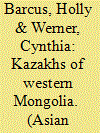

|
|
|
|
|
| Publication |
2010.
|
| Summary/Abstract |
The Kazakhs are the largest minority group in Mongolia, a relatively homogenous country dominated by Khalkh Mongols. Since 1991, Mongolia has transitioned politically and economically and witnessed significant changes in internal and international migration flows. The large-scale movement of ethnic Kazakhs from Western Mongolia to Kazakhstan represents one such emerging international flow. This migration is influenced by economic motivations, historical cultural ties to Kazakhstan, and immigration policies of both countries. This paper assesses the local and national circumstances that shape migration decision-making in Western Mongolia during the transition years and highlights changes in the characteristics and directions of migration flows during this time. We identify three periods of migration with each period characterized by changing economies and national policies in Mongolia and Kazakhstan, as well as changes in communications technologies and extensiveness of social networks among prospective migrants. These periods illustrate how transnational migration flows evolve through time and are affected by national, local, and individual circumstances.
|
|
|
|
|
|
|
|
|
|
|
|
|
|
|
|
| 7 |
ID:
178055
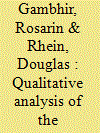

|
|
|
|
|
| Summary/Abstract |
The term Third Culture Kids refers to a person who has spent a significant part of his or her developmental years outside the parents’ culture. The number of Third Culture Kids is rapidly increasing and with that, so too are the social adjustment problems they face when repatriated. This qualitative research focuses on identifying and examining different social adjustment barriers that Third Culture Kids face when repatriated to their home culture due to their experiences and time spent abroad. This article aims to generate discourse and understanding of social adjustment problems that Third Culture Kids encounter. The authors intend to introduce an additional perspective to the proposed topic within the Thai context of Thai-Indian participants returning to Thailand after studying abroad. This exploration of the social adjustment of Thai-Indian participants identified five themes (1) Identity, (2) Sense of belonging, (3) Freedom, (4) Readjustment to Thai culture, (5) Intellectual Discouragement.
|
|
|
|
|
|
|
|
|
|
|
|
|
|
|
|
| 8 |
ID:
104011
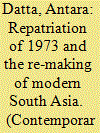

|
|
|
|
|
| Publication |
2011.
|
| Summary/Abstract |
In the aftermath of the 1971 war, nearly 250,000 people found themselves stranded in various parts of the subcontinent. These 'trapped minorities' became hostages in a complex negotiation process that highlighted how questions of citizenship and belonging remained unresolved in post-Partition South Asia. By studying three groups - the non-Bengalis, the Bengalis and the prisoners of war in a comparative perspective, this paper re-visits the question of who was welcome within certain borders and on what terms. It argues that these decisions depended not just on the state's policies towards 'outsiders' but also upon its own relationship with its minority communities.
|
|
|
|
|
|
|
|
|
|
|
|
|
|
|
|
| 9 |
ID:
191444
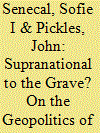

|
|
|
|
|
| Summary/Abstract |
The paper analyzes the institutions and regulations that govern the transnational movement of dead bodies in contemporary Europe. With the extension of free movement across the European Union and the subsequent expansion of transnational employment, tourism, and retirement, the repatriation of corpses from one member state to another lies in an ambiguous regulatory space. In exploring how dead bodies move between EU member states, and how their movements are regulated within transnational and national systems, the paper pays particular attention to the legacies and continued relevance of mid-century international agreements. Section 1 contextualises the issue of the transportation of mortal remains, discusses our broader theoretical background, and explains our research methods. Section 2 provides an historical overview of the foundational international regulations governing the repatriation of corpses: the 1937 Berlin Agreement and the 1973 Strasbourg Agreement. In Section 3, we present a comprehensive review of the discussion of repatriation of EU citizens between EU countries that occurred in the European Parliament and Commission between 2000 and 2018. In so doing, we focus on the ways in which understanding institutional action and inaction provides a lens on the operation of supranational competency development and its limits, and on the complex ways in which institutional arrangements are interwound within national, international, and transnational practices.
|
|
|
|
|
|
|
|
|
|
|
|
|
|
|
|
| 10 |
ID:
190898
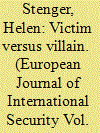

|
|
|
|
|
| Summary/Abstract |
State responses to repatriation of Islamic State (ISIS) foreign fighters and their children detained across Syria and Iraq are highly diverse. Repatriation policies implemented between 2018 and 2020 range from denying repatriation of nationals and revocation of citizenship to repatriation and subsequent gender-responsive rehabilitation programmes. What explains the variation in state responses? This article seeks to explain why repatriation policies differ despite the global challenges faced by all states. It investigates and categorises the repatriation policies for foreign fighters across 69 countries ranging from unconditional repatriation to denying repatriation. To explain the state responses to a common security and human rights dilemma, a mixed-method approach is employed involving an explorative statistical analysis to test key explanations and a narrative analysis. The findings reveal how diverse social constructions of gendered and racialised ‘threat narratives’ of foreign fighters in policy documents and the media explain variation in foreign fighter repatriation policies.
|
|
|
|
|
|
|
|
|
|
|
|
|
|
|
|
|
|
|
|
|